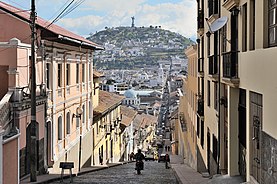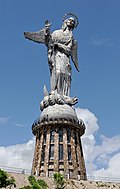geo.wikisort.org - Mountains
El Panecillo (from Spanish panecillo small piece of bread, diminutive of pan bread) is a 200-metre-high hill of volcanic-origin, with loess soil, located between southern and central Quito. Its peak is at an elevation of 3,016 metres (9,895 ft) above sea level. The original name used by the aboriginal inhabitants of Quito was Yavirac. According to Juan de Velasco, a Jesuit historian, there was a temple on top of Yavirac where the Indians worshiped the sun until it was destroyed by the Spanish conquistadores. The street that leads up to El Panecillo is named after Melchor Aymerich.
This article needs additional citations for verification. (October 2008) |


Statue

In 1975, the Spanish artist Agustín de la Herrán Matorras was commissioned by the religious order of the Oblates to build a 45-meter-tall stone monument of a madonna which was assembled on a high pedestal on the top of Panecillo.[1] Called "Virgin of El Panecillo", it is made of seven thousand pieces of aluminium. The monument was inaugurated on March 28, 1975, by the 11th archbishop of Quito, Pablo Muñoz Vega. The statue was engineered and erected by Anibal Lopez of Quito.
The virgin stands on top of a globe and is stepping on a snake, which is a classic madonna iconography. Less traditional are the wings. Locals claim that she is the only one in the world with wings like an angel. The monument was inspired by the famous "Virgen de Quito" (Quito's Madonna) also known as "the dancer" sculpted by Bernardo de Legarda in 1734, which now decorates the main altar at the Church of St. Francis. This madonna represents a turning point of the Quito School of Art (one of the most renowned of the Americas) because it shows a virgin in movement that is practically dancing in contrast with the traditional static Madonnas that were produced during the 18th century.
According to a bronze placard affixed to the monument, the woman represented by the statue is the Woman of the Apocalypse, as described in the Book of Revelation (12:1–17).
References
- "El Panecillo". Atlas Obscura. Retrieved 2020-10-02.
На других языках
[de] El Panecillo
El Panecillo (deutsch das Brötchen) ist ein Hügel mitten in Quito, der Hauptstadt Ecuadors. Quito liegt bereits etwa 2.800 m über dem Meeresspiegel. Der Hügel erhebt sich nochmals etwa 200 m über der Stadt und erreicht insgesamt eine Höhe von 3.035 m. Die Spanier gaben dem Hügel den Namen el Panecillo Anfang des 16. Jahrhunderts. In der Vorinkazeit wurde er Yavirac genannt, was auf ein Wasservorkommen hindeutet. Von den Inkas wurde er Shungoloma oder Herzhügel genannt.[1]- [en] El Panecillo
[es] El Panecillo
El Panecillo es una elevación natural de 3.000 metros sobre el nivel del mar, (200 metros más alto que el promedio de la ciudad de Quito) enclavada en el corazón mismo de la ciudad de Quito (Ecuador). Es el sitio más visitado de la ciudad. Por su ubicación se ha convertido en el más importante mirador natural de la ciudad, desde el que se puede apreciar la disposición urbana de la capital ecuatoriana, desde su centro histórico y hacia los extremos norte y sur. El Panecillo está coronado por una escultura gigante de aluminio de la «Virgen de Quito», creada por el español Agustín de la Herrán Matorras, el cual se basó en la obra compuesta por Bernardo de Legarda, uno de los más importantes representantes de la Escuela quiteña.[1][fr] El Panecillo
El Panecillo (de l'espagnol : « petit pain ») est une colline de Quito en Équateur. À son sommet se trouve la statue de la Vierge de Quito.Другой контент может иметь иную лицензию. Перед использованием материалов сайта WikiSort.org внимательно изучите правила лицензирования конкретных элементов наполнения сайта.
WikiSort.org - проект по пересортировке и дополнению контента Википедии